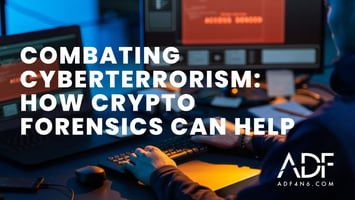As cyber threats and online criminal activities continue to become more sophisticated, it is...
Cryptocurrency and Forensics: How to Uncover Crypto-Related Crimes
Cryptocurrency continues to rise as a popular form of payment among criminal activities. A report released by Chainalysis stated that crypto-linked crimes amounted to approximately $14 billion in transactions [1]. Cryptocurrencies such as Bitcoin have several features that make them unique, such as:
- No central issuer, such as a government or bank
- The value is determined by supply and demand
- They are exchanged electronically through a peer-to-peer network
- They are less susceptible to economic or political problems that affect traditional currencies [2].
Although these characteristics set cryptocurrency apart from traditional currencies, Bitcoins can be used to buy goods. With this knowledge comes the realization that cryptocurrency fuels various online crimes. These crimes include:
- Ransomware- this malware blocks or encrypts users' systems and computers to demand a ransom payment in cryptocurrency to reinstate their system.
- Blackmail scam- cybercriminals threaten to release a victim’s personal information or details unless paid in cryptocurrency.
- Sextortion- involves blackmailing victims to obtain sexual favors. Cybercriminals may even threaten to post sexually explicit images or videos unless they are paid.
- Darknet market- individuals use online markets like the dark web to buy illegal goods or pay for illegal services.
- Bitcoin tumblers- are services that mix potentially identifiable Bitcoin transactions to obscure the trail of the original source, which otherwise would be publicly available in Blockchain [3].

Blackmail, sextortion, and ransomware are the most commonly reported crimes. According to Europol, cryptocurrency resists law enforcement disruption and government control due to its distributed nature [4]. This is why they have become a common form of payment in the crimes listed above.
To obscure some of these activities, individuals may use the dark web. Reports show that 57% percent of dark web content is illegal. This content includes pornography, illicit finances, illegal drugs, weapons, and terrorist communications [2]. Dark web investigations can help shed light on crypto-related crimes. That is why it is important to be familiar with internet sites. There are three types of internet websites:
- Surface web- is easily accessible to anyone and known as the World Wide Web. It is accessible through standard web browsers.
- Deep web- websites that are accessible through standard web browsers. However, they are considered inaccessible through or are not indexed by search engines and are not part of the deep web.
- Darknet or dark web- websites are unsearchable through common search engines. Special browsers are required to access the dark web. Users can browse while being protected from surveillance and their IP address is obscured [2]. The dark web can be accessed with an onion router or tor browser.
Crypto-related crimes can be uncovered using cryptocurrency forensics. Forensic investigators can track and interpret the flow of cryptocurrency assets on the blockchain. Digital forensics can be used to track browser history searches, for addresses or crypto transactions. Investigators can analyze system or user artifacts to unlock wallets or addresses of interest. These include password vaults, static text files, notes files, or encrypted archive files.
ADF’s Digital Evidence Investigator prioritizes and collects files and artifacts quickly. With DEI, investigators can use Collection Keys to obtain web browser cached files, social media, P2P, Cryptocurrency, cloud storage, user login events, anti-forensic traces, saved credentials, files shared via Skype, USB history, user connection log, etc.
DEI software may be used on Windows and macOS (including T2 and M1 chips). It can conduct Mac forensics and scan all available Mac computers with encryption and virtual drives by running a remote agent communicating with the desktop application. Most importantly, the DEI can quickly find Dark Web traces.
Crypto-related crimes can be difficult to uncover and track. Cybercriminals implement many tactics to remain anonymous. Powerful computer forensics software gives investigators everything they need to trace these damaging crimes.
Arm your agency with forensic software that can uncover crypto-related crimes.





